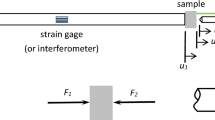Abstract
A rigorous experimental and numerical assessment is made of the benefits and limits of miniaturization in the Kolsky bar system. The primary issues that arise in very high strain rate testing (stress equilibration, inertial effects, wave dispersion, friction, and controllability of deformations) are addressed through experiments coupled with explicit finite element analyses. A miniaturized Kolsky bar system that includes the input bar is developed, together with the use of the laser occlusive radius detector to obtain local measurements of specimen strain during the very high rate deformations. It is demonstrated that this miniaturized Kolsky bar system can be used to provide fully validated results, including the explicit determination of equilibration, over a very wide range of strain rates (1×103 to 5×104 s−1). The desired high strain rate can be achieved even at low accumulated strains, and the total strain developed can be controlled very effectively. Specific conditions are developed for determining the range of utility of the technique for a given material. The technique is applied to the characterization of 6061-T651 aluminum, and the results are compared with the results obtained using a conventional Kolsky bar.
Similar content being viewed by others
References
Nicholas, T. andRajendran, A.M., “Material Characterization at High StrainRates,” inHigh Velocity Impact Dynamics, J.A. Zukas, ed., Wiley, New York, 127–296 (1990).
Walley, S.M. andField, J.E., “Strain Rate Sensitivity of Polymers in Compression From Low to High Strain Rates,”DYMAT Journal,1,211–228 (1994).
Ravichandran, G. andSubhash, G., “A Micromechanical Model for High Strain Rate Behavior of Ceramics,”International Journal of Solids and Structures,32,2627–2646 (1995).
Li, Y., Ramesh, K.T., andChin, E.S.C., “The Compressive Viscoplastic Response of an A359/SiCp Metal-Matrix Composite and of the A359 Aluminum Alloy Matrix,”International Journal of Solids and Structures,37,7547–7562 (2000).
Clifton, R.J. andKlopp, R.W., “Pressure—Shear Plate Impact Testing,” inAmerican Society of Metals Handbook, ASM International, Materials Park, OH, 230–239 (1985).
Gray, G.T. III, “Classic Split Hopkinson Pressure Bar Testing,” inASM Handbook, H. Kuhn andD. Medlin, eds, ASM International, Materials Park, OH, 462–476 (2000).
Davies, E.D.H. andHunter, S.C., “The Dynamic Compression Testing of Solids By the Method of the Split Hopkinson Pressure Bar,”Journal of the Mechanics and Physics of Solids,11,155–179 (1963).
Bell, J.F., “An Experimental Diffraction Grating Study of the Quasistatic Hypothesis of the SHPB Experiment,”Journal of the Mechanics and Physics of Solids,14,309–327 (1966).
Bertholf, L.D. andKarnes, C.H., “Two-dimensional Analysis of the Split Hopkinson Pressure Bar System,”Journal of the Mechanics and Physics of Solids,23,1–19 (1975).
Über Fortpflanzungsgeschwindigkeiten kleiner Schwingungen in einem unbegrenzten isotropen Kreiszylinder,”Journal für die Reine und Angewandte Mathematik,81,324–336 (1876).
Chree, C., “The Equations of an Isotropic Elastic Solid in Polar and Cylindrical Coordinates: Their Solution and Application,”Transactions of the Cambridge Philosophical Society,14,250–369 (1889).
Bancroft, D., “The Velocity of Longitudinal Waves in Cylindrical Bars,”Physical Review,59,588–593 (1941).
Green, W.A., “Dispersion Relations for Elastic Waves in Bars,” inProgress in Solid Mechanics, I.N. Sneddon andR. Hill, eds, North-Holland, Amsterdam, 225–261 (1960).
Gorham, D.A., “A Numerical Method for the Correction of Dispersion in Pressure Bar Signals,”Journal of Physics E: Sci. Instrum. 16,477–479 (1983).
Gong, J.C., Malvern, L.E., andJenkins, D.A., “Dispersion Investigation in the Split Hopkinson Pressure Bar,”Journal of Engineering Materials and Technology,112,309–315 (1990).
Gorham, D.A., “Specimen Inertia in High Strain Rate Compression,”Journal of Physics D: Applied Physics,22,1888–1893 (1989).
Edington, J.W., “The Influence of Strain Rate on the Mechanical Properties and Dislocation Substructure in Deformed Copper Single Crystals,”Philosophical Magazine,19,1189–1206 (1969).
Lindholm, U.S., “Deformation Maps in the Region of High Dislocation Velocity,” inHigh Velocity Deformation of Solids, J. Shioiri, ed., Springer-Verlag, Berlin, 26–35 (1978).
Follansbee, P.S., Regazzoni, G., andKocks, U.F., “The Transition to Drag Controlled Deformation in Copper at High Strain Rates,”Institute of Physics Conference Series,70,71–80 (1984).
Dharan, C.K.H. andHauser, F.E., “Determination of Stress—strain Characteristics at Very High Strain Rates,” EXPERIMENTAL MECHANICS, 10, 370–376 (1970).
Wulf, G.L., “The High Strain Rate Compression of 7039 Aluminum,”International Journal of Mechanical Science,20,609–615 (1978).
Gorham, D.A., “Measurement of Stress—strain Properties of Strong Metals at Very High Strain Rates,”Institute of Physics Conference Series,47,16–24 (1980).
Safford, N.A., “Materials Testing Up to 105 s −1 Using a Miniaturized Hopkinson Bar With Dispersion Corrections,” inProceedings of the 2nd International Symposium on Intense Dynamic Loading and its Effects, G. Zhang andS. Huang, eds., Sichuan University Press, Chengdu, China, 378–383 (1992).
Gorham, D.A., Pope, P.H., andField, J.E., “An Improved Method for Compressive Stress—strain Measurements at Very High Strain Rates,”Proceedings of the Royal Society of London, Series A,438,153–170 (1992).
Shioiri, J., Sakino, K., andSantoh, S., “Strain Rate Sensitivity of Flow Stress at Very High Rates of Strain,” inConstitutive Relation in High/Very-High Strain Rates, K. Kawata andJ. Shioiri, eds., Springer-Verlag, Berlin, 49–58 (1995).
Kamler, F., Niessen, P., andPick, R.J., “Measurement of the Behavior of High-purity Copper at Very High Rates of Strain,”Canadian Journal of Physics,73,295–303 (1995).
Ramesh, K.T. andNarasimhan, S., “Finite Deformations and the Dynamic Measurement of Radial Strains in Compression Kolsky Bar Experiments,”International Journal of Solids and Structures,33,3723–3738 (1996).
Jia, D., The Mechanical Behavior of Nanostructured Materials, PhD dissertation, Johns Hopkins University (2001).
Wang, F. andLenard, J.G., “An Experimental Study of Interfacial Friction-hot Ring Compression,”Transactions of the ASME: Journal of Engineering Materials Technology,114,13–18 (1992).
Gorham, D.A., “The Effect of Specimen Dimensions on High Strain Rate Compression Measurements of Copper,”Journal of Physics D: Applied Physics,24,1489–1492, (1991).
Malinowski, J.Z. andKlepaczko, J.R., “A Unified Analytic and Numerical Approach to Specimen Behavior in the SHPB,”International Journal of Mechanical Science,28,381–391 (1986).
Jia, D., Ramesh, K.T., andMa, E., “Effects of Nanocrystalline and Ultrafine Grain Sizes on Constitutive Behavior and Shear Bands in Iron,”Acta Materialia,51,3495–3509 (2003).
Author information
Authors and Affiliations
Rights and permissions
About this article
Cite this article
Jia, D., Ramesh, K.T. A rigorous assessment of the benefits of miniaturization in the Kolsky bar system. Experimental Mechanics 44, 445–454 (2004). https://doi.org/10.1007/BF02427955
Received:
Revised:
Issue Date:
DOI: https://doi.org/10.1007/BF02427955




